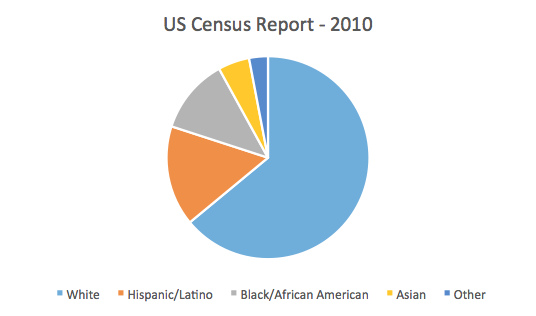Next month brings us the 13th annual Executive Women’s Forum conference in Scottsdale, Arizona, where people gather to discuss information security topics with a focus on women in technical and leadership positions. People often wonder why having diversity in these positions is such an important thing; this is why I felt it important to cover this subject in my recent webcast.
How diverse is tech?
Women make up about 47 percent of the overall workforce in the US, and slightly over half (almost 52 percent) of management, professional and related positions. And during the last census taken in 2010, almost 64 percent of the population identified themselves as White, over 16 per cent as Hispanic or Latino, 12 percent as Black or African American, almost five per cent as Asian, and three per cent as "other", which includes people of two or more races, American Indians or Alaska Natives and native Hawaiians or other Pacific Islanders.

Depending on whose statistics you look at, within technology companies, about one quarter of people in computer and engineering positions identify themselves as women. According to the National Center for Women in Technology, of those women, 90 percent identified themselves as White, five per cent as Asian, three per cent as African American and two percent as Hispanic. According to (ISC)2 and the consulting firm Frost & Sullivan, in information security, the number is less than half that of technology overall at 11 percent. Considering the general makeup of the population in any given country, this percentage is remarkably skewed.
Diverse populations are healthy populations
Increasing diversity within one of the fastest-growing employment sectors isn’t just important because of the idea that some sense of fairness that must be maintained. Whether we’re talking about bugs in the garden or genes in a population, diversity is an important indicator of a thing’s health and future prosperity.
Studies have also shown that having a more diverse workplace makes financial sense. According to a study by MIT, for example, workplaces which have an even split of women and men have revenue increases of up to 41 percent.
According to a Gallup poll, diverse workplaces have 39 percent higher customer satisfaction, 22 percent greater productivity and 27 percent higher profitability. They also have 22 percent lower employee turnover. According to a Catalyst report, Fortune 500 companies with at least three female directors have seen their return on invested capital increase by at least 66 percent, return on sales increase by 42 percent, and return on equity increase by at least 53 percent.
Technology has great potential to improve everyone’s lives, and people of all demographics and in every type of job need to interact with it. It’s important for everyone’s success for all different types of people to want to have a hand in the creation of technology.
At this point in time, the vast majority of people in tech are of a similar age and ethnicity as well as gender. That lack of diversity doesn’t bode well. We need people who have a variety of different skills and educational backgrounds, of all ages, all ethnicities and socioeconomic backgrounds, as well as genders. The more people we have with different experiences, the more useful technology will be to that ever-growing variety of people.
Now what?
Now that we see why increasing diversity in hiring is beneficial, the question we must ask is: "Why are there so few women and minorities in tech?" Is it that there are few people available to be hired or are the people who are there leaving quickly?
Some of the most famous individuals in the early years of computing were women. But the number of women who go into computer-related degree programs has been on a downward trend since the 1980s. That may be in part due to a cultural trend of computers being marketed as “toys for boys”, meaning that boys benefit from experience with coding from an earlier age, while girls tend not to.
Of the women who do go into careers in computing, more than half of them leave midway through their career. Of those women, 24 percent take a non-technical job in a different company;, 22 percent become self-employed in a tech field, 20 percent take time out of the workforce, and 10 percent go to work with a startup company.
There is also evidence that the pool of potential applicants is considerably wider than what we’re currently accessing: top universities report that they’re graduating twice as many African American and Hispanic people with computer science degrees than are being hired in tech jobs. And unemployment rates for women in computer careers are greater than for men.
The bright side of this is that this means that there is a significant number of women and minorities who are available to help address the shortage of workers needed in information security and technology positions.
Resources:




